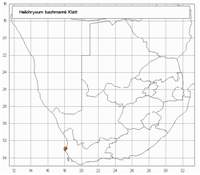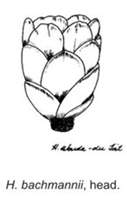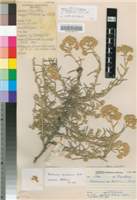Origin of name:
bachmannii - after Frans Bachmann (1856-1916), explorer in Pondoland
Diagnostic characters:
Open branched inflorescences
Description:
Well-branched, scrambling shrub up to 2 m tall, young branches greyish-white tomentose, leafy, more distantly so below the inflorescences. Leaves mostly 13-35 x 2-3 mm, scarcely diminishing upwards, linear-lanceolate or linear, apex acute, mucronate, base slightly narrowed, half-clasping, margins strongly revolute, both surfaces greyish tomentose. Heads heterogamous, campanulate, c. 4 x 3 mm, many in corymbose clusters corymbose-paniculately arranged. Involucral bracts in 4 series, graded, loosely imbricate, inner about equaling flowers, not radiating, tips very obtuse, opaque white. Receptacle with fimbrils about equaling ovaries. Flowers c. 13-20, 4-6 female, 9-15 homogamous. Achenes not seen, ovaries with highly myxogenic duplex hairs. Pappus bristles many, scabrid, bases cohering strongly by patent cilia.
Flowering between August and November.
Distribution:
Grows on sand or rock outcrops. Recorded from the environs of Velddrif, Vredenburg and Hopefield in the Swartland of the SW. Cape.
Fynbos Biome.
Notes:
Very rarely collected.
Taxonomy:
Literature:
Helichrysum bachmannii Klatt in Bull. Herbarium Boissier 4: 459 (1896).
Type:
Western Cape, south of Hopefield, Nov. 1886, Bachmann 1202 (Z, holo.).
Synonym(s):
Vouchers:
Acocks 19685 (PRE); Boucher 2910 (NBG); Marsh 1274 (K, mixed with H. revolutum).


